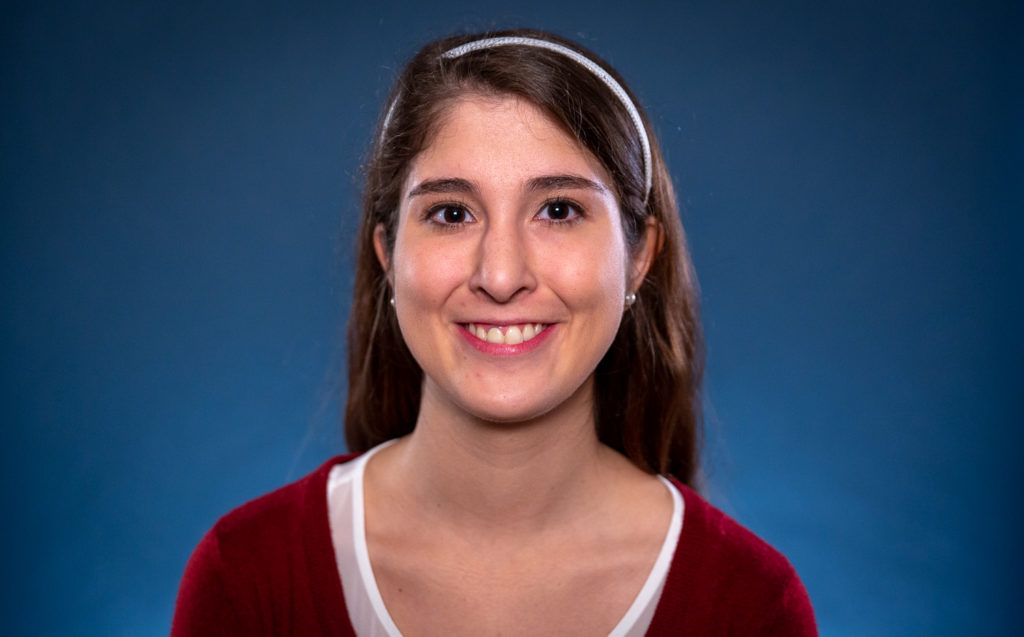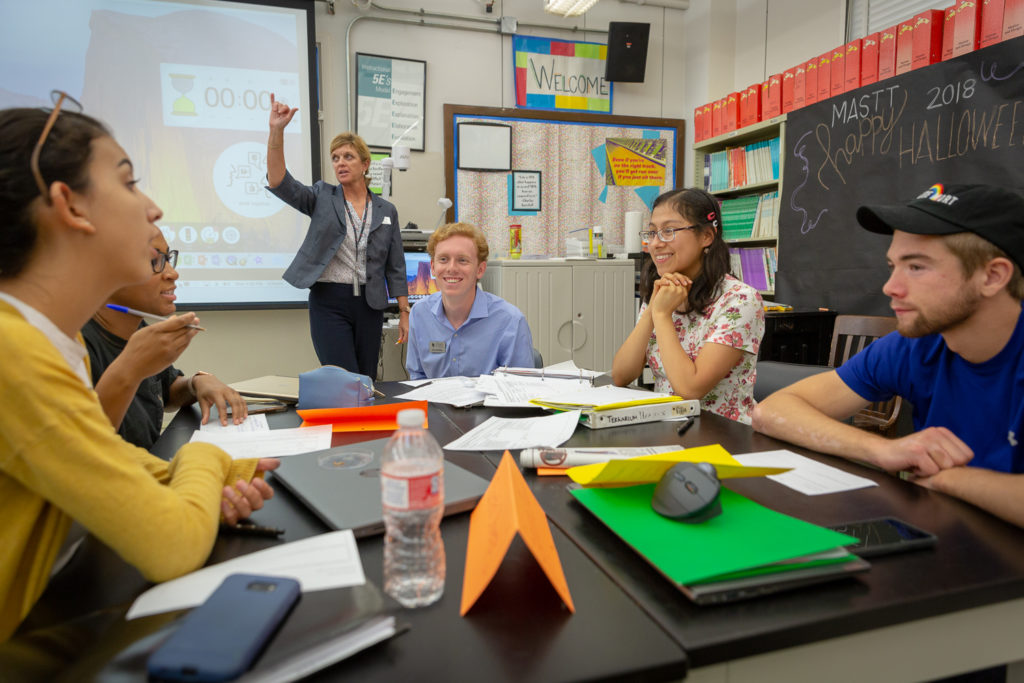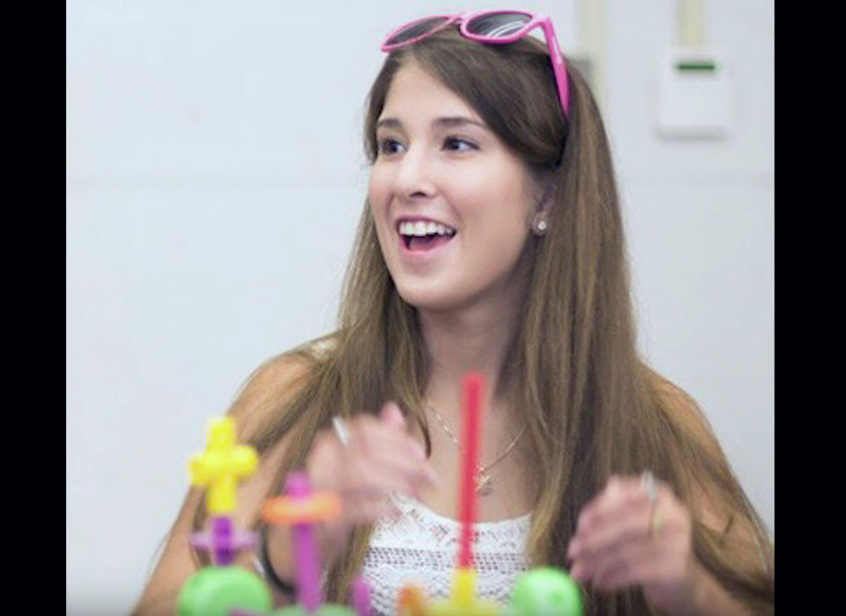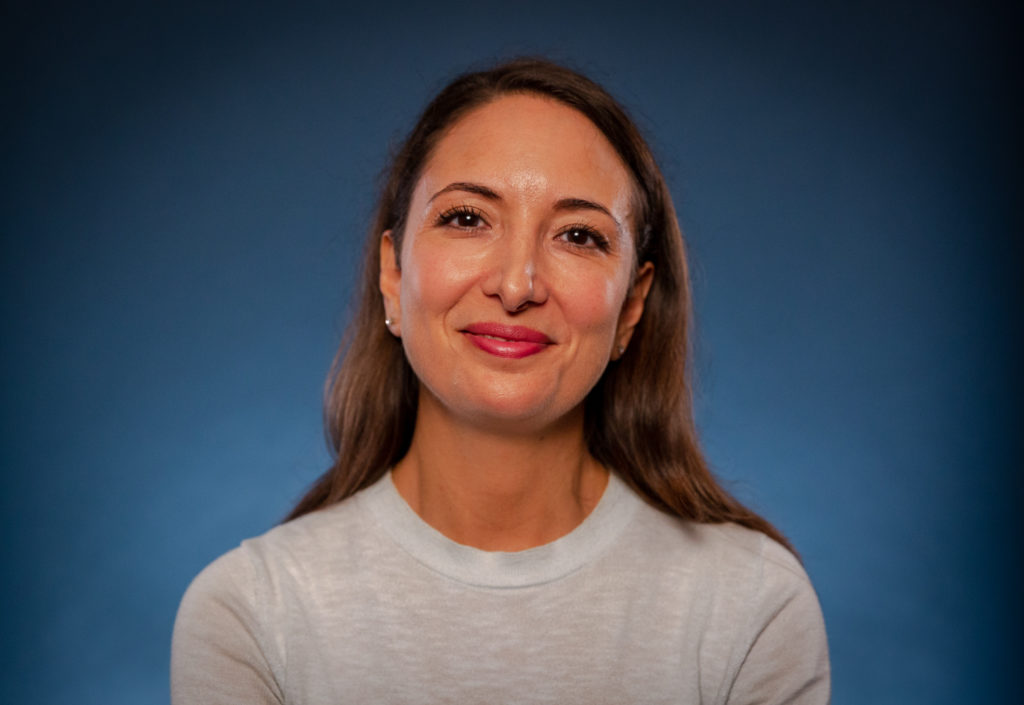Sometimes all it takes to change the course of science and math education is a lightbulb moment. UTeach is showing future teachers how they can find this moment within themselves and inspire this moment in their students.
Helping students achieve the “lightbulb moment” is the most rewarding part of the program, The University of Texas at Austin junior Garrett Mott said about joining UTeach.
“It’s just the face they make, and they’re like so excited about science and math. And just seeing it actually work and play out, I think that’s the coolest thing,” Mott told WorkingNation.

The moment happened for UTeach graduate Kira Lowery too when she saw a photo of herself during her first UTeach class. It’s the figurative lightbulb going off — the “a-ha moment” — that said to her she was going to be a teacher.
“I think in that moment I realized I looked so happy in the photo teaching that it was what made me happy and that I wanted to pursue it,” said Lowery, who teaches seventh-grade science at NYOS Charter School in Austin, Texas.

Now at 44 colleges in 21 states and Washington D.C., UTeach has spread its education model to address the nationwide shortage of science and math teachers. The program’s success starts by asking science and math majors one simple question, “Do you want to try out teaching?”
Answering yes to this question starts a journey for undergraduates to explore teaching careers while they earn a bachelor’s degree in a STEM discipline. UTeach then takes them into the classroom to test their curiosity, where many of UTeach students experience a lightbulb moment and discover they have a love for teaching.
Since 1997, UTeach has prepared thousands of college students for teaching careers through a streamlined program that combines professional development with practical experience in the classroom.
Its origins started in the late 1980s when Texas lawmakers changed the requirements for math and science teachers. To teach STEM classes at Texas secondary schools, teachers had to have majored in relevant coursework. According to UTeach founder and current Senior Vice President and Provost of the University of Maryland, Dr. Mary Ann Rankin, this provided the College of Natural Sciences, where she served as Dean, with an opportunity to collaborate with the College of Education on the preparation of STEM teachers. She gathered experts from the different disciplines to come up with something new to attract UT STEM majors to consider teaching.

“I expected these wonderful people to work for maybe a couple of weeks and come up with some general guidelines that we could then build from. But instead, they worked all summer and fleshed out detailed descriptions of what this program could be,” Rankin said.
That meant creating a program that would convince science and math majors to prepare for teaching careers while concentrating on their major at UT. UTeach matches master teachers with students for a “try-before-you-buy” teaching experience made up of two, one-credit courses: Step 1: Inquiry Approaches to Teaching and Step 2: Inquiry-Based Lesson Design. These classes take place at local elementary and middle schools where UTeach participants deliver engaging, inquiry-based lessons that make science and math fun for everyone.
The positive teaching experience and environment can change their mind about the profession and consider teaching as an alternative to a career in the private sector. UTeach helps remove the stigma surrounding education by unlocking the passion within college students to pass on their knowledge to kids.
“Actually, once people do try teaching, in many cases they realize that it’s the best kind of career there is, and it’s really meant for them,” Rankin said.
Following the success of the pilot, the UT College of Natural Sciences and the College of Education formally partnered together to develop and administer the program. Rankin said that the program was built with an eye to expansion. UTeach’s unique program was hailed in a national report detailing the crisis in STEM training in 2007, drawing the notice of other universities. With the support of the National Math and Science Initiative and private sector funding, UTeach would spread out of Austin and to 43 more schools.
UTeach functions as a minor where students concentrate on their preferred major. STEM degree plans with the UTeach teaching option are designed to be completed in four years, thus there is no extra cost for students. Adding teaching certification to their degree expands career options for students.
Following graduation, they have considerable practice teaching in real classrooms, know research on how people learn and are certified to teach secondary STEM. They are also prepared to pursue a STEM career or graduate school. There is no commitment to join the teaching profession, but the program is so effective that 87 percent of UTeach graduates do become teachers.
Before the creation of UTeach, the number of STEM teachers coming from UT Austin had been dropping precipitously. This signaled a major problem in Texas where the number of STEM-based careers was rising. Without STEM-trained teachers sharing their in-depth knowledge base, the next generation of workers would not be introduced to the skills to work the high-tech jobs of tomorrow.
Tech companies were flocking to Texas, creating a tech hub that capitalized on the workforce pipeline that was beginning to take shape in the state’s capital. According to the Texas Workforce Commissioner Ruth Hughs, meeting the demand for STEM-educated workers and teachers is the key to the state’s economic future ensuring that high-tech jobs continue flowing into the state.

“We have 744,000 jobs that are STEM-related in Texas. That puts us second in the nation in STEM jobs, and we need to make sure we continue to grow that number because the need is continuing to grow,” Hughs said.
UTeach is a scalable solution that sees its success being replicated nationwide. By 2022, UTeach projects a total of 7,659 graduates will impact the lives of more than 5 million students. If UTeach-educated teachers inspire just a fraction of their students to explore a STEM profession, then the nation will be poised to maintain its economic competitive advantage.
Just having a fifth-grade teacher who was excited about the natural sciences was enough to convince UTeach student Mott to pursue his love of science and math. He said that he understood how important it is for kids to get the same enthusiasm from him. Mott credited a succession of “really great teachers” who inspired him to become a teacher.
“Those are the people that really shape the way that you grow up, and the way you start to perceive the world because they’re teaching you how to think critically, and think more actively about the world around you,” Mott said.

Those experiences convinced Mott early on to pursue teaching when he applied to UT. He checked yes on the college application which asked if he wanted to be a teacher. Originally, he planned on becoming a music teacher but learned that the pathway was more complicated and took longer to complete compared to UTeach. Immediately in his first semester, Mott was taking UTeach courses, going through Step 1 and Step 2 with other STEM majors like him. Painter Hall, the home of the UTeach program, became a second home for him.
“I spend so much time there, and it’s awesome to have everyone in one place together, as like a little mini family, because you know everyone by name,” said Mott. “It’s such an environment that you begin to call your own and have all your friends there, and you make all your friends through your UTeach classes, and you all grow up together in the program.”
Lowery said that the positive learning environment at UTeach helped convince her to reconsider her choice of a pre-med major. She discovered UTeach through the UTeach Outreach program. She signed up for Step 1 during the second semester of her freshman year to see if she liked it.
That was when the photo of her teaching the initial class was taken. Lowery said that she was “building this little contraption” for one of the challenges that her students also completed. It was a different world to her compared to her demanding pre-med courses.

“They make this positive environment for learning and being a lifelong learner. And I think that’s what I’m trying to do as a teacher, too, is show my students it’s okay to always be a lifelong learner and it’s okay to have fun learning, too,” Lowery said.
Seeing herself in the moment of discovering her real passion was what turned her educational path toward teaching. She decided that her future was going to be in a classroom, not a doctor’s office.
“I think in the moment that I saw the photo of myself from UTeach teaching that I realized that every moment that I’ve spent in a classroom and every moment that I’ve spent in my UTeach classes was enjoyable for me and that I actually was having fun doing that,” Lowery said.
Both Lowery and Mott consider UTeach their family and the bonds they created with their teachers and fellow students extends beyond their time at UT. Lowery noted that she can always reach out and get a reply, even though she has graduated and moved on to teaching. The program is designed to provide induction support that graduates can receive continuous feedback to improve their teaching skills.
“They’re always available for help and support and encouragement, and even provide resources that I may need for my classroom. I really think that UTeach is more than just a program, it’s definitely a community and a family,” Lowery said.
NYOS Charter School’s Principal Curtis Wilson said that Lowery is the “epitome of the entrepreneur-type teacher” that the school wants. He said that his school hired several UTeach graduates because the program’s focus on equitable teaching practices and innovation aligns with the NYOS mission.
“Kira constantly explores new ways to connect with students. She’s constantly looking at best practices, and research, and what works for students, what yields that kind of learning,” Wilson said.

Mott hopes to find a physics or math teaching job in the Austin area so that he can give back to his community. UTeach Institute Associate Professor of Practice and master teacher Shelly Rodriguez said that his positive demeanor and passion for teaching physics would make him a leader wherever he lands.

Rodriguez, who taught both Mott and Lowery, believes that one day they will become master teachers themselves because of their drive and enthusiasm for teaching.
Her prediction about Mott and Lowery is a lightbulb moment too.
“I know both of them; I don’t even have to say it’s a hope, they will be teacher leaders. Kira, already, has started her school’s first Maker Fair, so that’s been pretty exciting to see. And Garrett is a natural leader, so I know that they will both be picking up the mantle,” Rodriguez said. “Eventually when I’m out of teacher preparation and out of teacher education, I’m sure one of the two of them will end up taking my spot.”
To learn more about UTeach and the UTeach Institute: Click Here.
Join the Conversation: Tell us what you think of our latest Do Something Awesome mini-documentary and the UTeach program on our Facebook page.
© Copyright 2024 by Structural Unemployment, LLC dba WorkingNation